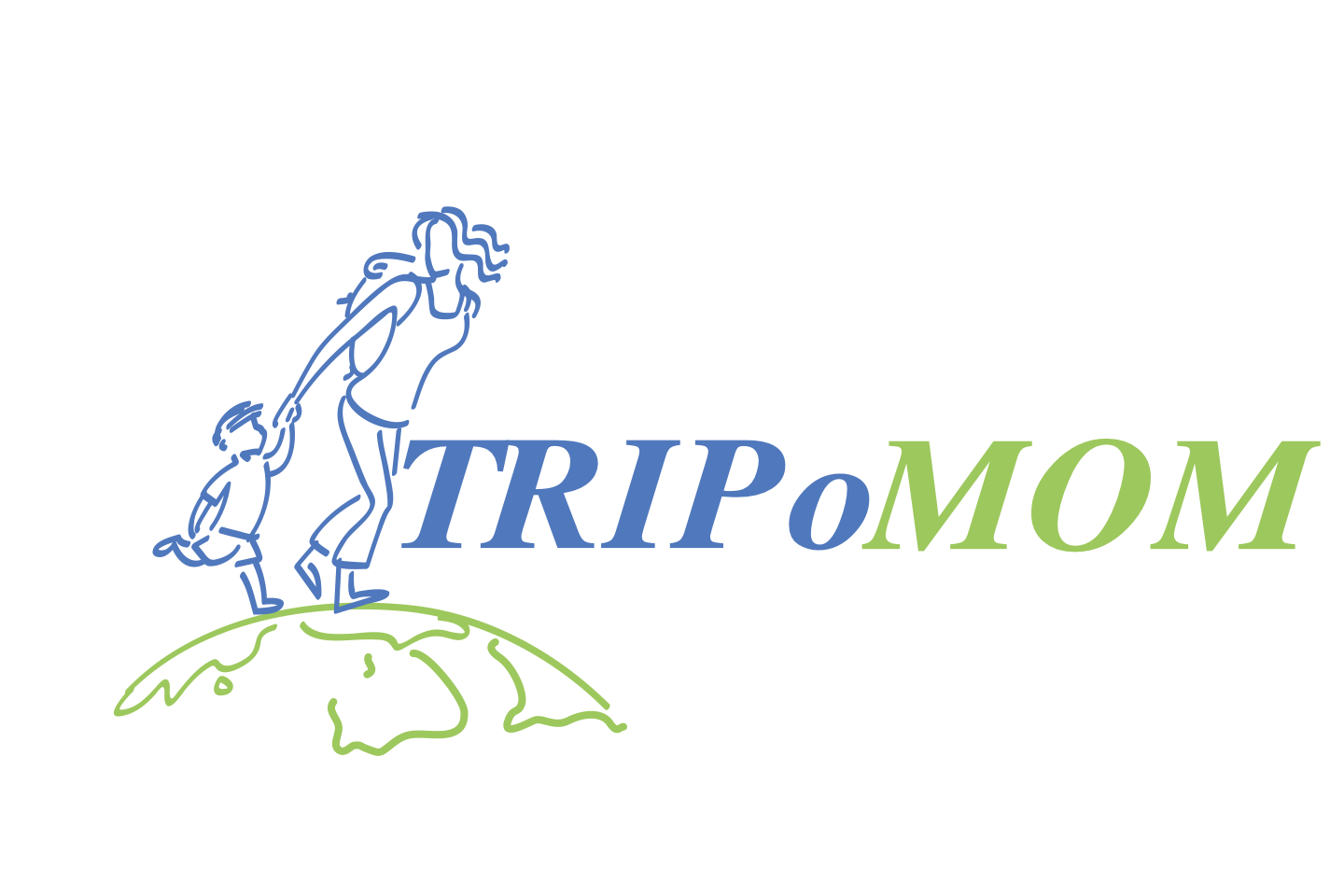
Alsace is a picturesque region in France with vast vineyards and fairytale looking villages all around. Being located on the border of France and Germany, the region is a perfect mixture of the two cultures. It is also a great destination for foodies with its unique wines produced at hundreds of vineyards through 170 km Alsace wine route, good restaurants and leisurely stroll around atmosphere.
We went to a little “take it easy and enjoy the life” vacation in Alsace region. We drove through the Alsace wine route by car and visited the most famous Alsace villages during our road trip. After spending 3 days in Alsace region, Colmar and Strasbourg, we crossed to Germany and visited Black Forest region on our way back to the airport.
| Disclosure: Some of the links bellow are affiliate links, meaning that at no cost to you, I will receive a commission if you click through and make a purchase. For more Information, read my affiliate disclosure here. |
What is the Alsace Wine Route?
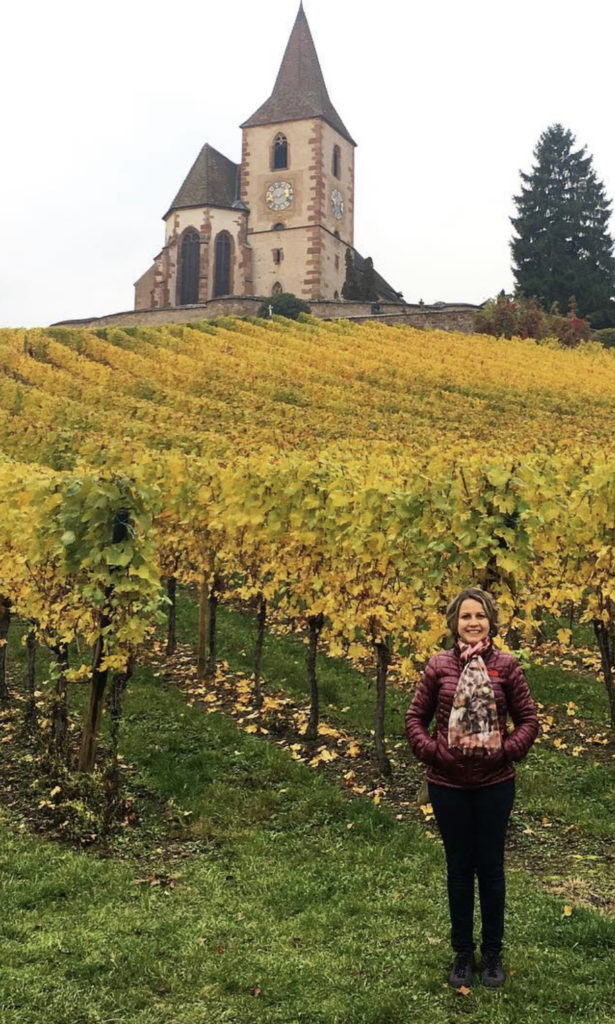
The Alsace Wine Route is the oldest wine route in France. Its history goes all back to the Roman times when vineyards first appeared in the region. The route winds its way through tens of wine growing cute villages and hundreds of wine producers. Running 170 km from north to south, The Alsace Wine Route is one of the prettiest tourist trails in the world with its exceptional landscapes, colorful Alsatian villages and medieval castles.
Where is Alsace wine route located?
Alsace region is situated in north eastern France. The Alsace wine route lies through the part of French – German border where Rhine River separates the two countries. It goes from north to south on the west banks of Rhine river all the way to the Switzerland border. Thanks to its location between Vosges mountains in France and Black Forest in Germany, the region has a sunny and dry micro climate making it the driest area in all France, which is perfect for wine production.
Alsace wine route villages

There are 119 wine growing villages through Alsace. Those villages are the kind of the most authentic and picturesque ones with beautiful half timbered houses, colorful flowers on windowsills and festive atmosphere. In other words finding a pretty village is not hard through the Alsace Wine Route. The question is which one to choose to visit among the tens of options. We focused in the most famous Alsace villages and towns, thus visited Eguisheim, Colmar, Ribeauville, Kaysersberg, Riquewhir, Obernai and Strasbourg.
How many days do you need in Alsace?
How many days to spend in Alsace is totally up to what kind of trip you want to have. You can drive through all the region and visit the most popular villages and towns in a single day. In order to experience the Alsace wine route more deeply you would need at least three days in the region. Moreover, the region is a perfect cyclist’s paradise, a destination to slow up and soak up the atmosphere at your own pace.
We drove through the Alsace Wine Route in 3 days. Since we were driving a car we didn’t choose to visit the wineries during the day but made our itinerary in order to stay and dine in the villages with the best restaurants and enjoy some evening wines.
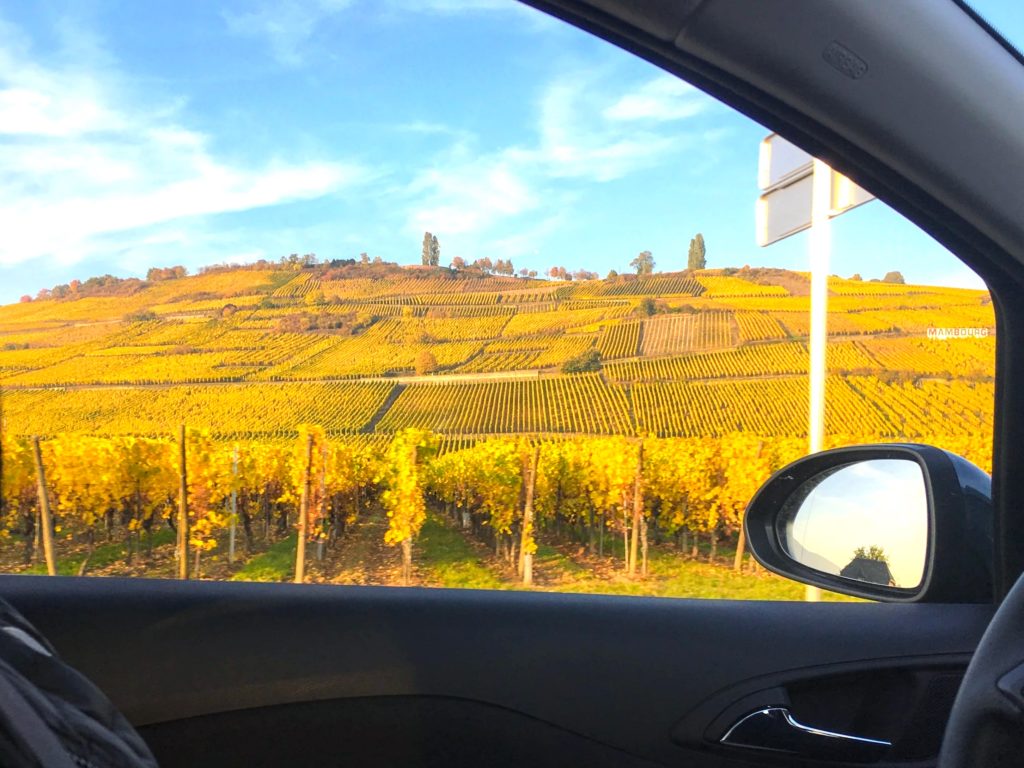
When to visit Alsace?
The best time to visit Alsace, Strasbourg and Colmar for most people is undoubtedly Christmas time. The region has the best Christmas markets and turns into a fairytale like atmosphere during Christmas.
In addition, summertime is also popular with its pleasant temperatures to explore the region and vineyards. Hiking, cycling or driving through the wonderful landscapes and lush green vineyards in summer is phenomenal. Strolling in the picturesque villages surrounded with colorful flowers all around and enjoying the great atmosphere of summer wine festivals sounds amazing.
For us, we preferred to visit the region in fall in October. The fall foliage of the golden vineyards was incredible. The weather was a little cool but pleasant enough and mostly sunny. Also, thanks to visiting the Alsace region in shoulder season, we had an unforgettable trip since we could afford to stay at the best hotels in Alsace.
Where to stay in Alsace region?

Strasbourg and Colmar are the two main cities in Alsace region that can be good options to spend a night or two. Strasbourg is the capital city of Alsace. It has a lively urban atmosphere with a beautiful old town and lots of places to explore. Colmar is certainly the prettiest place in the region and has many stores, attractions and restaurants to spend great time.
We stayed in both Colmar and Strasbourg in Alsace. In addition to them we wanted to stay in one of the villages to experience the region more. It wasn’t easy to pick one among the many charming villages. Eventually we opted in for Riquewhir since it had a pretty main street with lots of stores and a few good restaurants where we could enjoy a delightful meal.
What to eat and drink in Alsace?
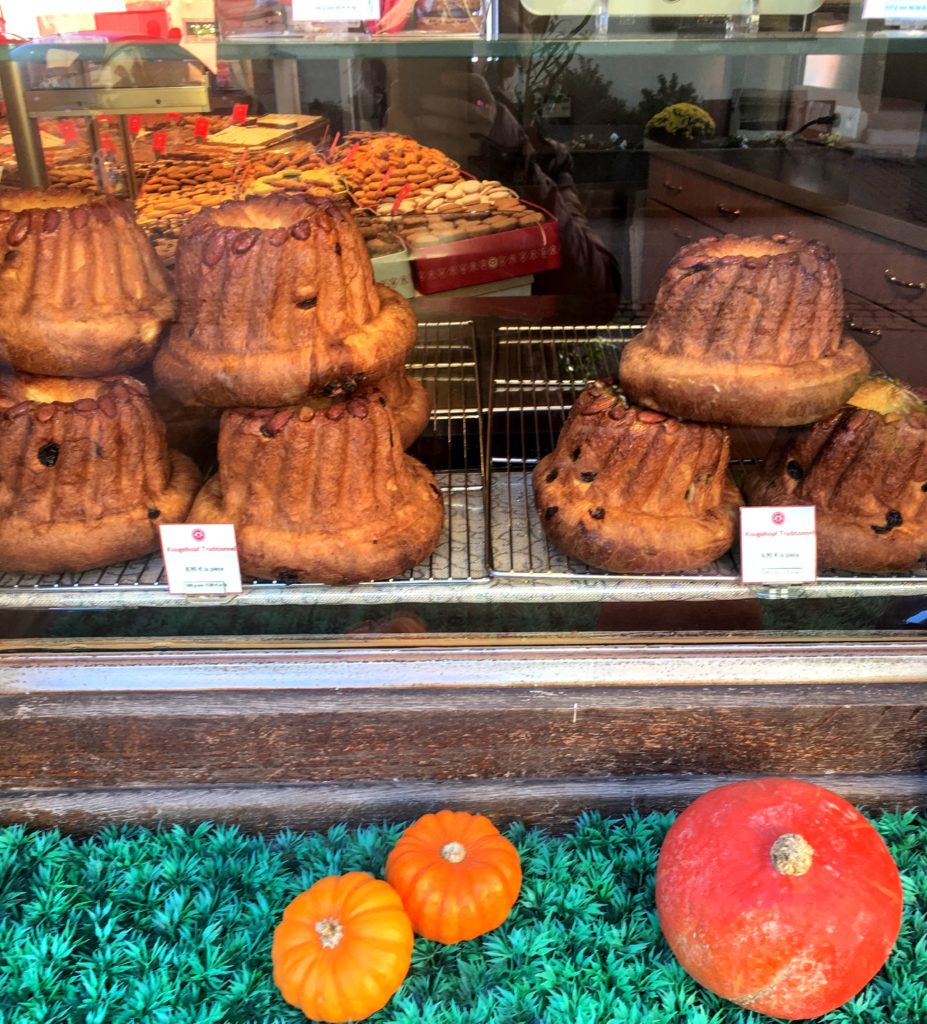
Alsatian cuisine is mostly German influenced. Sour cabbage dishes (“Choucroute garnie” in Alsatian, sauerkraut in German) are served with potatoes, sausages and pork or beef even fish. Hearty casseroles (Backeoffe), tartes (Tarte flambée) and cakes (Kugelhopf) are great comfort foods that can be enjoyed in many authentic, homey bistros known as winstubs in the region.
Honestly, although I like eating some German dishes now and then, German cuisine is not my number one choice. Yet, in addition to Alsatian cuisine Alsace is one of France’s leading gastronomic regions where there are many exquisite restaurants and innovative chefs that use local ingredients to cook incredible dishes. In fact, the famous foie gras was invented there in Strasbourg in 1780! Also, Alsace area has a very high concentration of Michelin starred restaurants. There are 24 one starred, 4 two starred, 5 green starred and 21 Bib gourmand Michelin restaurants in Alsace region.
Wines of Alsace
The thing about Alsatian wines impressed me the most is that they are not the usual wines that you buy at your local supermarket. If you are not a wine expert, you would probably taste the wine varieties produced in the region for the first time there, which adds a lot to the whole Alsace experience. Wines of Alsace are predominantly white wines. They are mostly light, dry, fruity and so flavorful!
Alsatian wines’ outstanding whites are produced mostly from four noble grape varieties: Riesling, Muscat, Pino Gris and Gewürztraminer. There are also Pinot Blanc and Sylvaner white wines produced in the region. Among all these white wine verities Alsace wine region is known for its German influenced Rieslings. Our favorites though during our trip were Pino Gris (rounded and balanced, moderately acidic a complex wine) and Gewürztraminer (a powerful aromatic wine with a complex bouquet).
If you opt in for red wine, the only Alsatian red is Pinot Noir. Also, there is an Alsatian sparkling wine known as Cremant d’Alsace.
Where do you fly into to go to Alsace?
There are two main airports to get to Alsace: Strasbourg and Basel-Mulhouse EuroAirport. Strasbourg is on the northernmost part of the region and Basel-Mulhouse is on the southernmost part. Which means, when you fly into Strasbourg Airport, you explore the region from north to south. On the other hand, when you fly into Basel-Mulhouse EuroAirport you explore from south to north.
Traveling Alsace from north-south or south-north?
We found a cheaper flight to Basel-Mulhouse EuroAirport and started our road trip from there. By going from south to north in the Alsace region, we traveled among the prettiest villages first and after that we visited Strasbourg. Since we already had been in the most charming towns on our way, Strasbourg didn’t impress us very much (although it’s quite a beautiful city). When you start your journey from north to south the level of cuteness will increase with each mile you go and may be it could be more impressive. Nevertheless, either way would be an unforgettable trip for sure!
Our Alsace wine route itinerary
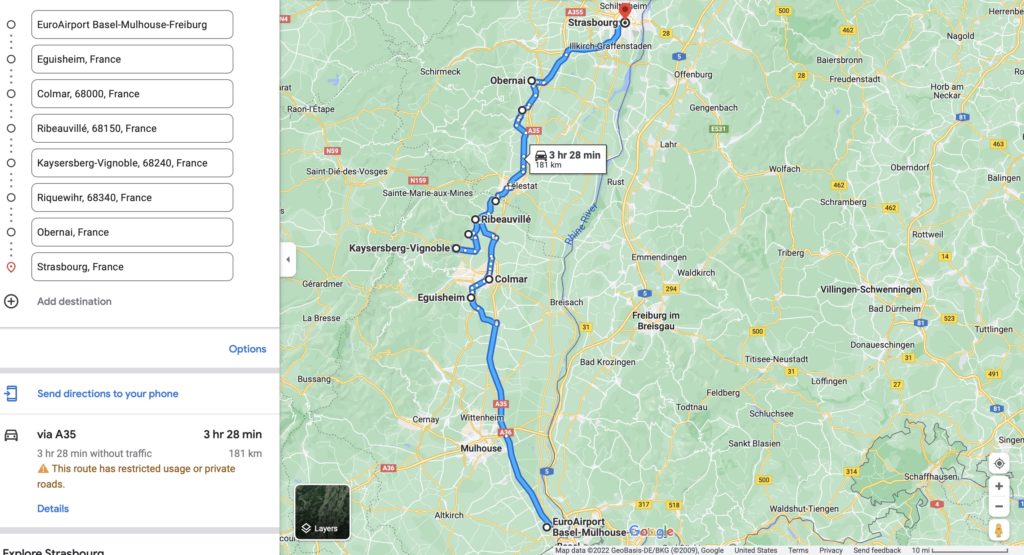
- Day 1: Fly into Basel-Mulhouse EuroAirport early in the morning and rent a car at the airport. Visit Eguisheim and Colmar. Spend the night in Colmar.
- Day 2: Explore Colmar more in the morning. Drive to Alsace Wine Route villages. Visit Ribeauville, Kaysersberg and Riquewhir. Stay in Riquewhir for the night.
- Day 3: Drive all the way through Alsace Wine Route up to Strasbourg. Visit some Alsace villages on your way. Spend the afternoon and the evening in Strasbourg.
- Day 4: Cross the German border and drive through Black Forest region of Germany. Visit Triberg and Freiburg. Go back to Basel-Mulhouse EuroAirport late in the afternoon and board to your plane back home.
EuroAirport: Basel Mulhouse Freiburg Airport
EuroAirport, the airport we flew into for our Alsace vacation, is quite a unique place itself. It is an airport operated by two different countries: France and Switzerland. Despite the airport is situated on French lands, it is at the connecting point of France, Germany and Switzerland and is used to travel to all three of them. There are two different border security checks for France and Switzerland. That’s why depending where you are traveling to you need to exit through either Swiss or French / German exit when you land at the airport.
In our case, we went through the French border check. After passing the security we rented our car from Avis car rental at the airport and off we go we were driving through French highways. The highway A35 is also very close to the airport, thus we were at the first stop of our itinerary, in Eguisheim, in just 40 minutes after we left the airport.
Eguisheim
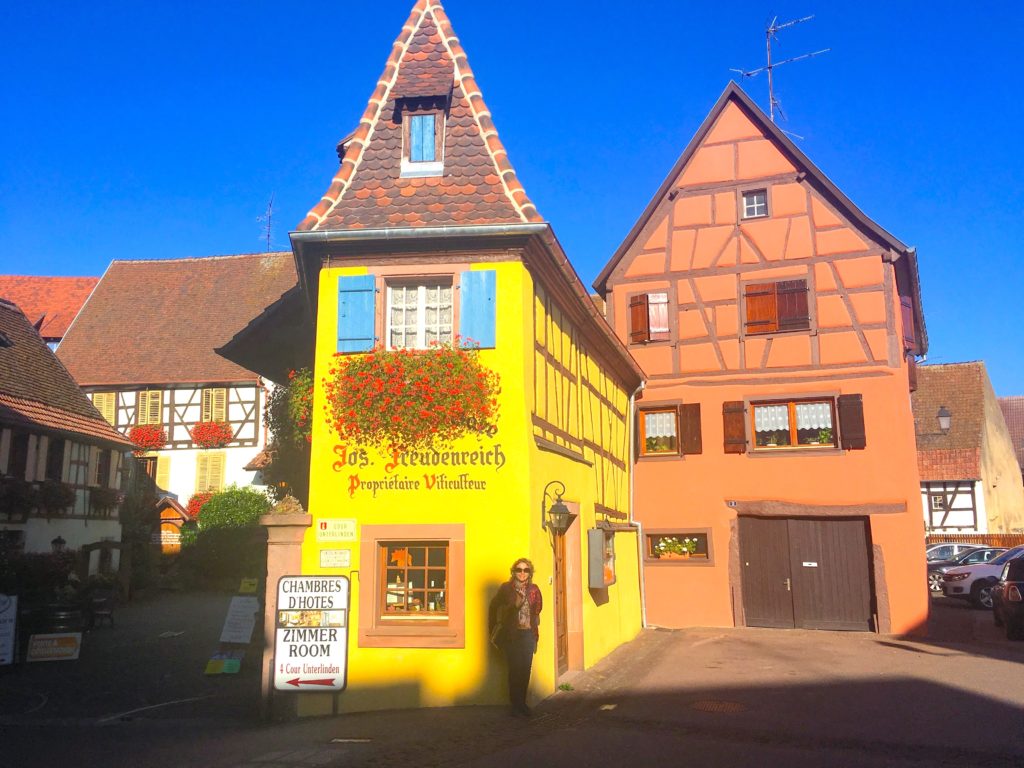
Eguisheim is a picturesque village just 15 minutes drive to the famous Alsatian town Colmar. In fact, it is a medieval town surrounded with 13th century walls and many historic houses throughout the town. It is a kind of a place that will awe you with its cuteness. There are colorful half timbered houses all around streets. The windows of the houses are all decorated with flowers in full bloom. Eguisheim is ranked as “One of the Most Beautiful Villages in France” and won a title of “France’s Favorite Village”.
Eguisheim was a perfect place to kick off our Alsace Wine Route road trip. It was charming, small, cute and full with Alsatian atmosphere. Actually it was such a little village that you could walk all around in an hour or so.
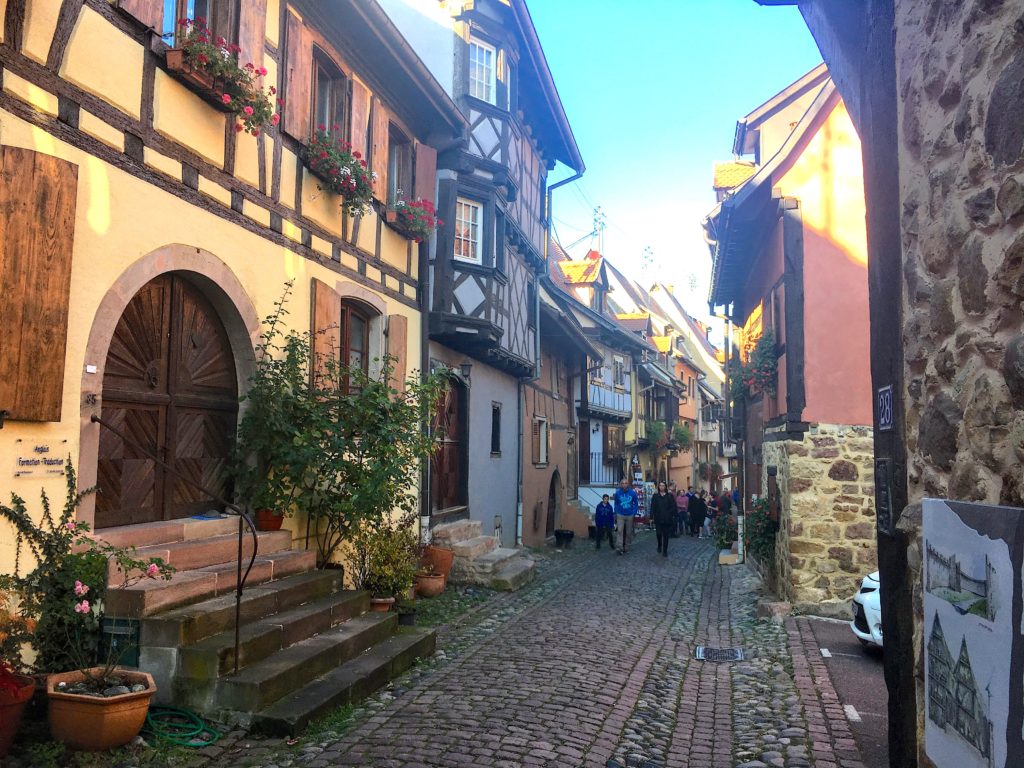
As soon as we arrived to Eguisheim we parked our car outside the town walls and started following the “Eguisheim Discovery Trail“. Tha map of the trail was displayed at the town entrances and all the remarkable things to see were explained on the map. Indeed, there were only a few circular streets surrounding the town center. We walked through the cobbled streets, bought some local cheese from the shops, spent some time at the medieval center of the town and enjoyed some mulled wine accompanied with the delicious smell of cookies baked at the bakeries nearby.
Colmar
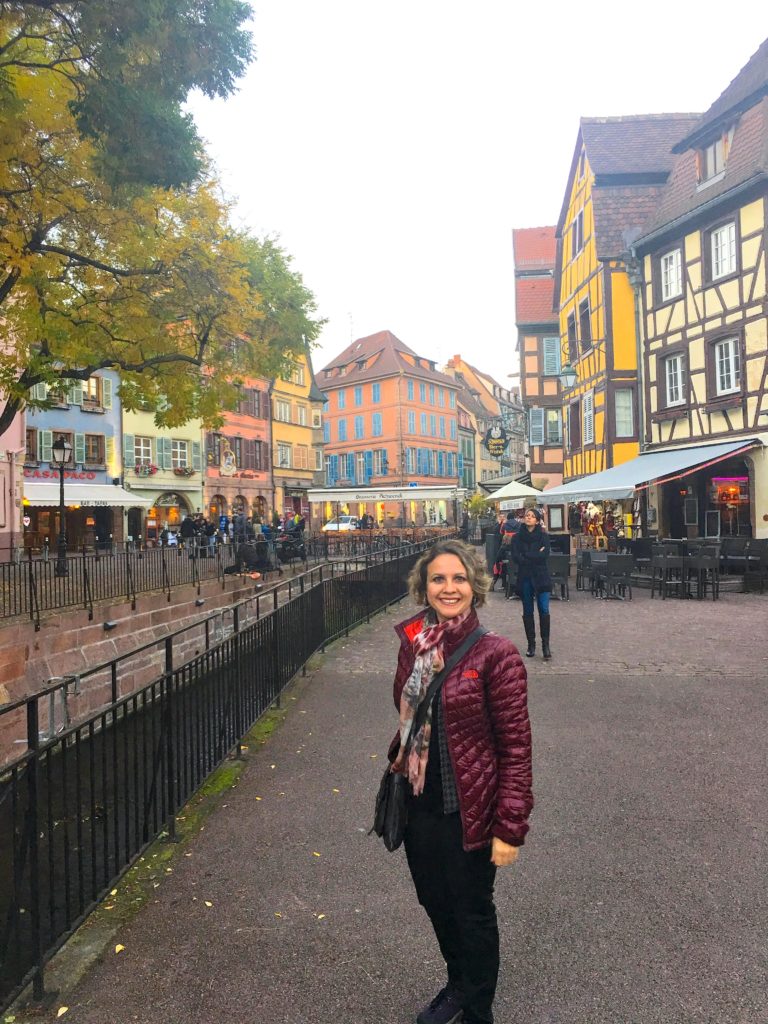
Can Colmar be the prettiest place on Earth? Colmar is not a little town like the cutie villages around the region. Yet, despite its relative larger area, it is still very charming wherever you go. There are colorful half timbered houses, historical buildings, pretty cafes, fancy restaurants; everything just perfect for a leisurely vacation!
Top things to see in Colmar
- Little Venice: An iconic neighborhood in Colmar with canals and colorful pretty houses (the photo below). You can go for a little boat ride in Little Venice and enjoy the fairytale like atmosphere.
- Le Quai De La Poissonnerie: Once a fishmonger’s district, where fish was stored and sold, today the top touristic destination in Colmar. Snapping a photo of the colorful half timbered houses by the canal is a must in a visit to Colmar (my first photo of this blog post).
- The Pfister House: A medieval house built in 1537. It is the first example of architectural renaissance in Colmar.
- The Covered Market: A metal framed brick building from 1865 where merchants sell fruits, vegetables, butchery, baked pastries and many more.
- Saint Martin Church: An important example of Gothic architecture in Colmar that is built between 1235 and 1365.
- The Koifhaus: The oldest public building in Colmar built in 1480.
- The Statue of Liberty: The sculptor of the famous Statue of Liberty, Auguste Batholdi, was born in Colmar. To commemorate the 100th death year of the sculptor a 12-meter high replica of the statue was placed in the northern entrance to the town. Snapping a photo with the famous statue is a popular tourist attraction in Colmar.
Where to stay in Colmar?
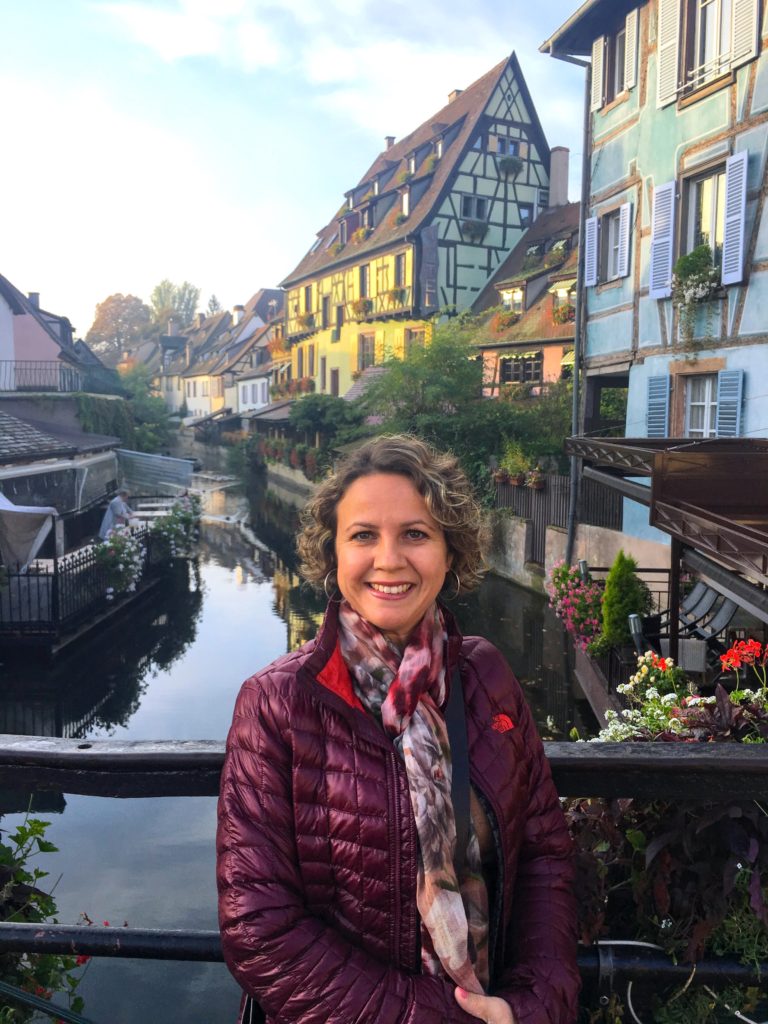
In Colmar, we stayed in Hotel Le Marechal, a beautiful hotel in the picturesque quarter in the town known as Little Venice. Our hotel was just on the bank of the canal where all the tourists take pictures of the area or enjoy a boat ride. Staying in a historic half-timbered building constructed in 1565 was quite cool. It was an elegant accommodation decorated with antique furniture all around.
Sinse we went in shoulder season, we found quite an affordable price to stay in Hotel Le Marechal. For prices during your vacation for Hotel Le Marechal (Booking.com score 8.6 / for more than 1200 reviews) check the link here.
For more options of hotels to stay in Colmar please click here.
Where to eat in Colmar?

Colmar is a city renowned for its gastronomy. Actually, the restaurant scene in Colmar has something for everyone, from casual foodie to more enthusiastic fine dining lover. There are great French food restaurants, wine bistros or Alsatian winstubs, plenty of choices to choose.
At our only night in Colmar, we wanted to experience Michelin star dining. We didn’t have any reservations, which normally is a must to dine in a Michelin stared restaurant. We walked around the old town, took a peek at the menus of the Michelin starred places and opted in for the one which would not break the bank. Thankfully we could make a last minute reservation in L’Atelier du Peintre where we had an exquisite fine dining experience.
Driving through the Alsace Wine Route
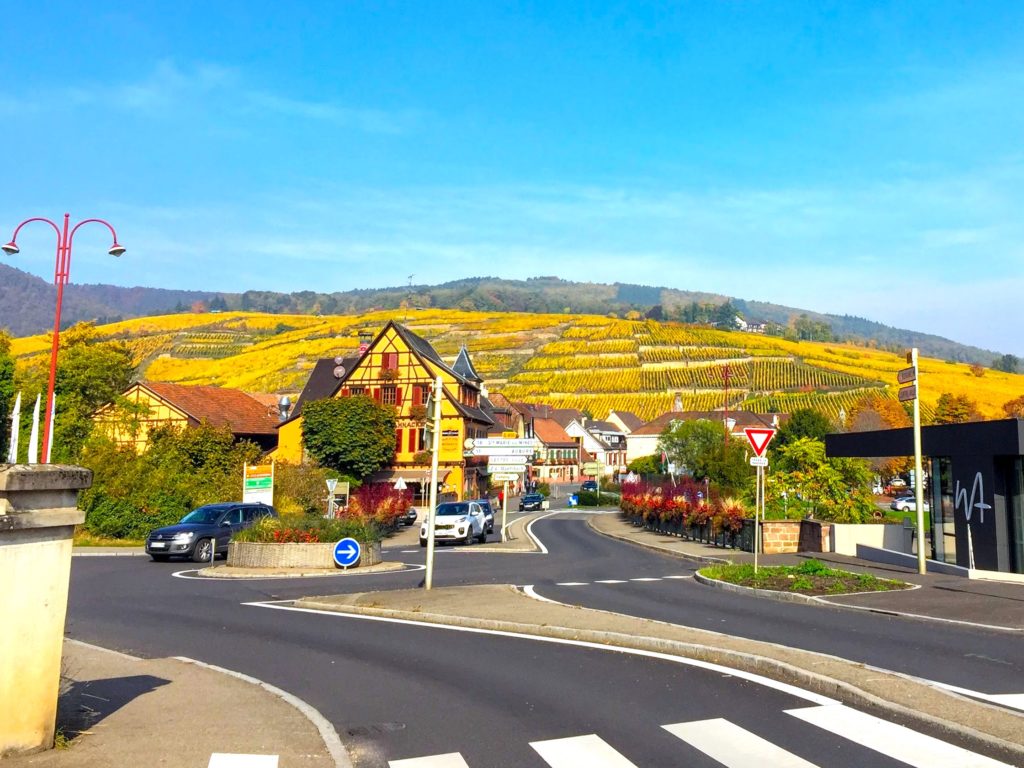
After a delightful morning of exploring the beautiful Colmar, we were ready to continue on our road trip through the Alsace Wine Route. It was a pleasant sunny day on which vast golden vineyards looked even more pretty. We had planned to stay in Riquewhir, another stunning town in Alsace, that day. That’s why, before visiting Riquewhir we explored its two charming neighbor villages: Ribeauville and Kaysersberg.
Ribeauville
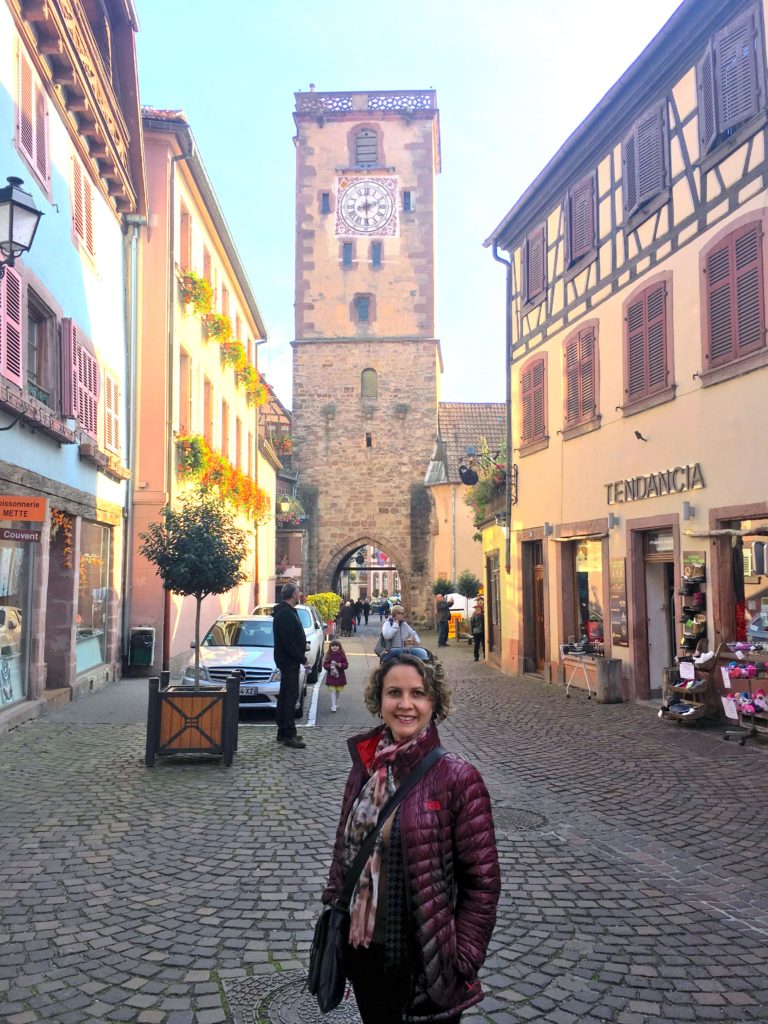
Once the seat town of the Lords of Ribeaupierre in the Middle Ages, charming Ribeauville still successfully preserves its historical heritage. Situated between vineyards and mountains on the Alsace Wine Route (Route des Vins), Ribeauville is a lovely place to stroll around.
The Ribeaupierres (whom the town is named after) built three fortified castles around the town. The ruins of those castles still can be seen after a short hike on the mountainside, just outskirts of the town. Yet, after a short stroll in the beautiful town streets, we hiked through the footpaths to find those castles. The ruins of the castles were not so magnificent but the view of the town in the middle of vast golden vineyards was amazing!
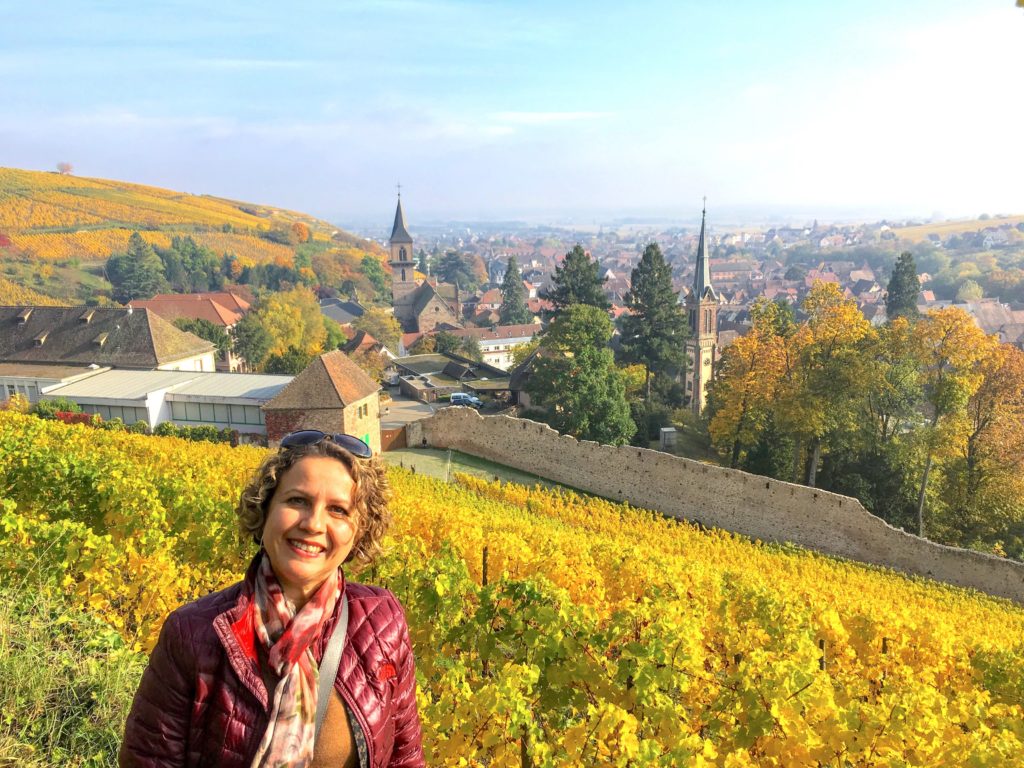
Where to eat in Ribeauville?
We planned to have an early lunch in Au Relais des Menetriers, a highly rated restaurant in Ribeauville that also is a Michelin Bib gourmand. It is not overpriced for a good quality meal in a tourist town. Anyways, we didn’t have a reservation but we thought we could find a table since it was just the opening time. We were wrong. It was a shame we couldn’t eat there because I feel like it was going to be one of the best meals of the trip. If you decide to eat there, don’t forget to make a reservation from the restaurant’s link above!
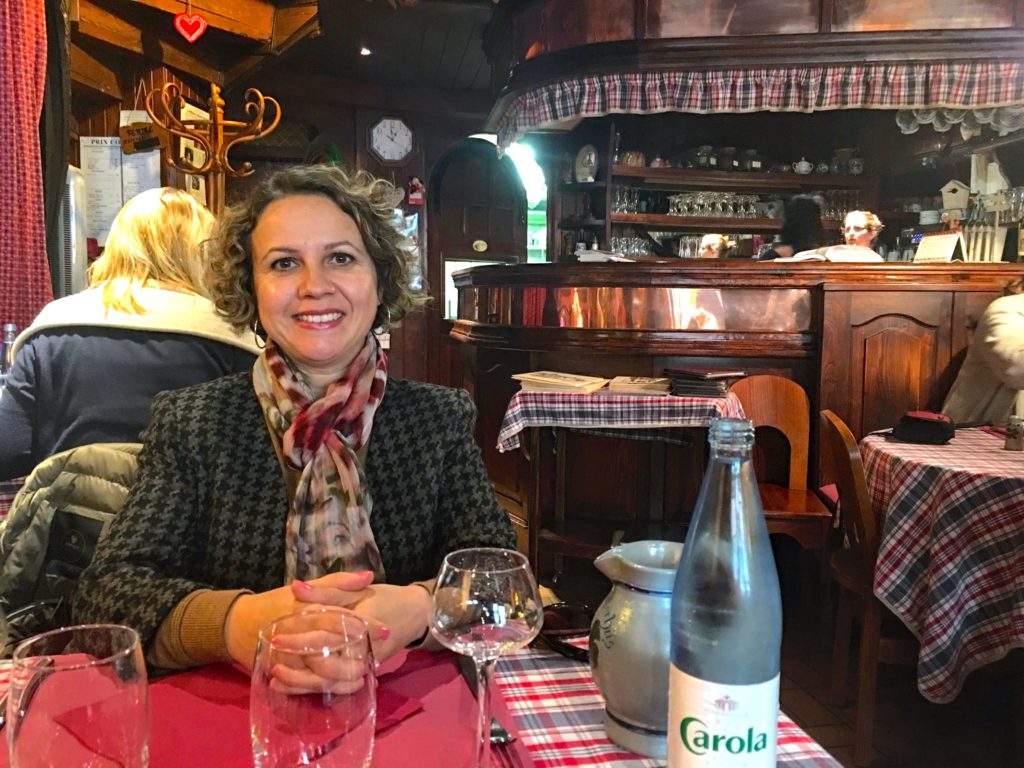
Eventually, we decided to have a traditional Alsatian winstab experience and chose to eat in Winstab zum Pfifferhaus in the Main Street. It was really an authentic meal in a great traditional atmosphere. We tried some Alsatian dishes like sauerkraut and some Alsatian wine. It was a good place to try some local cuisine.
Kaysersberg

Kaysersberg is another fairy tale town close to Colmar. Its name means “Emperor’s Mountain” in German and it has a beautifully preserved historical architecture like all the other places we visited during our Alsace Wine Route trip. Actually, Kaysersberg was the place where we went, “ok, we got this, all the places in Alsace are super cute, what we’ve got next :)”. Although this may be true, Kayserberg is worth visiting for its less crowded but equally charming and quaint atmosphere.
Riquewihr
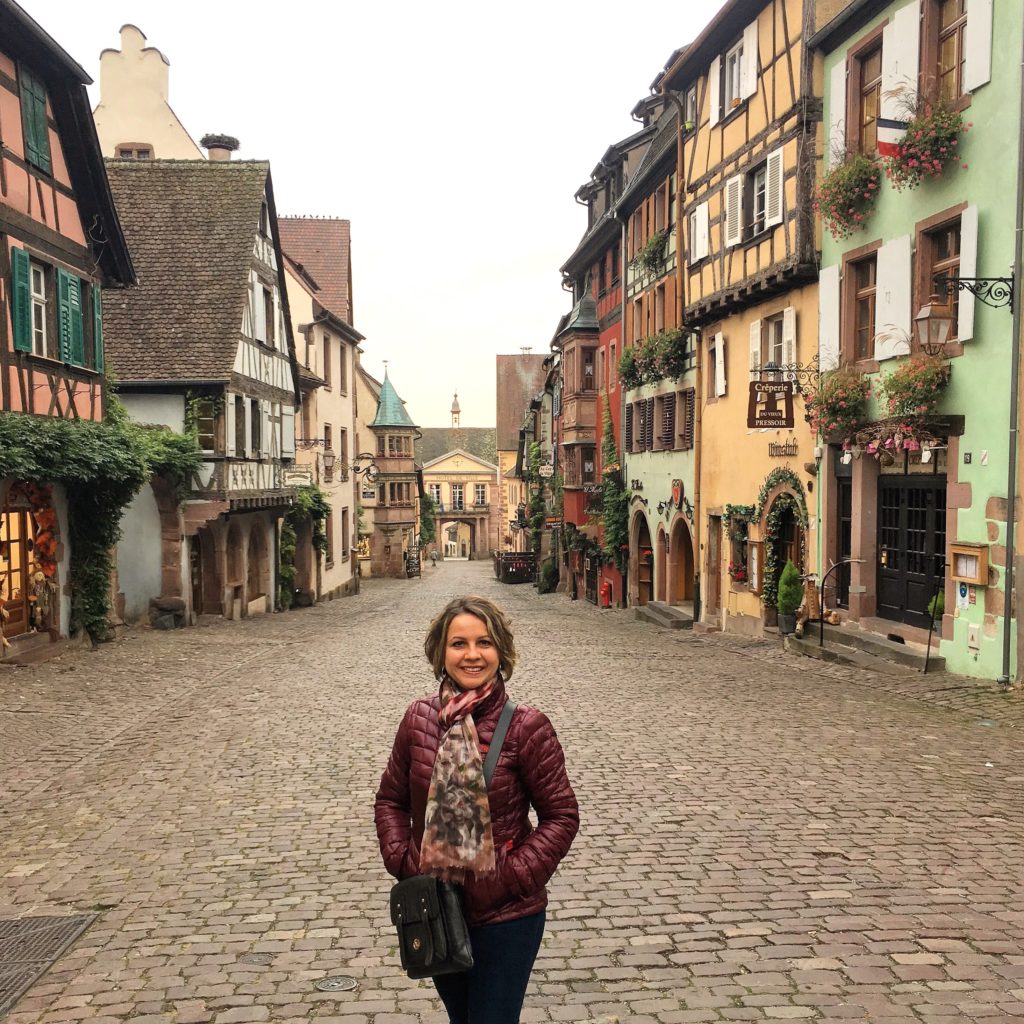
Riquewihr is one of the popular touristic villages ideally located in the center of Alsace. It is like an open air museum with its preserved authentic character behind the city walls. Half timbered houses from 15th – 18th centuries, beautiful main street with lots of shops, cafes and restaurants, many historical boutique hotels to stay in definitely add so much to the Alsatian experience. Moreover, it has a nick name of “Gem of the Alsace Vineyards” because of the quality of its wines.
Riquewihr was the Alsace village that we decided to spend one night and take in the quaint atmosphere more. We stayed in a historical hotel, walked around the many shops in the main street, ate in an exquisite chef’s restaurant, tried some Alsatian wine and had great time there.
Where to stay in Riquewihr?

There are many authentic boutique hotels to stay in Riquewhir. We stayed in Hotel de la Couronne (Booking.com score 8.3/ for more than 1200 reviews), a family run hotel just in the center of Riquewihr. It is a traditional Alsatian building with rooms that have original oak beams and medieval furnishing. Hotel de la Couronne, also has a large private parking lot available on site. It was a pleasant and relaxing stay there.
For more choice of places to stay in Riquewihr, please click here.
Where to eat in Riquewhir?
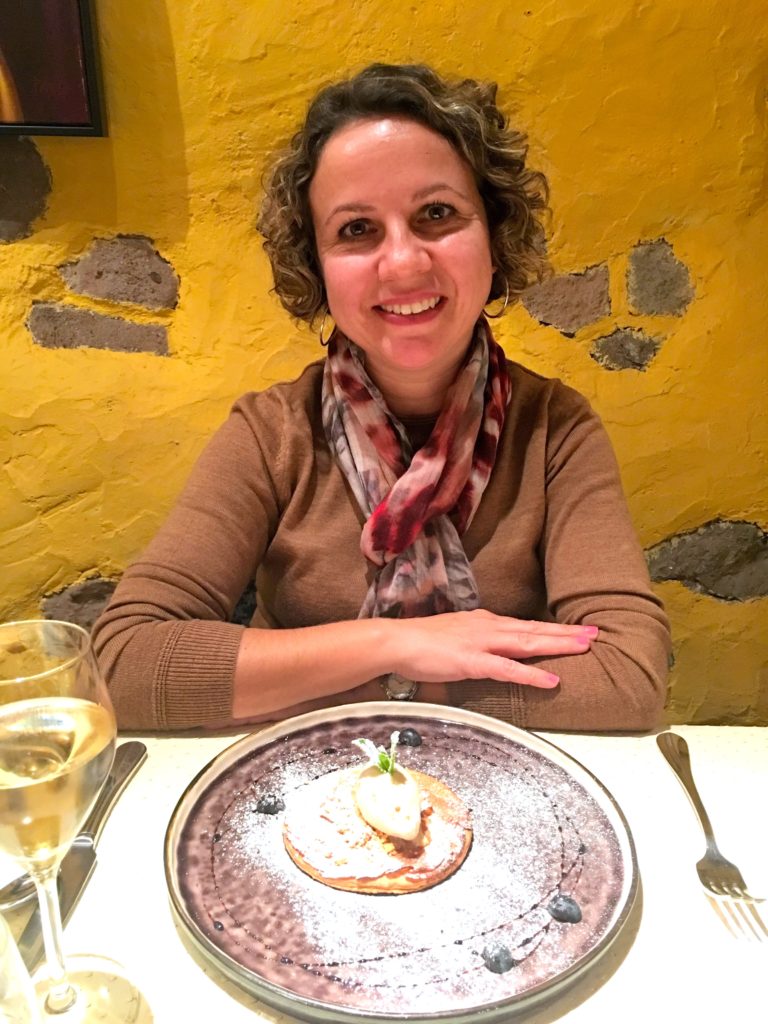
There are many good restaurants to dine and wine in Riquewihr. (TripAdvisor’s best restaurants of Riquewihr list is here.) Alsatian, French, European, fine dining ones; the list is quite long for such a little town. There are even five Riquewihr restaurants in the Michelin guide. Among the places we could find a table to make a reservation we chose to dine in Au Trotthus, a French Japanese fine dining restaurant that is also listed in Michelin guide. We had a tasting menu paired with different local wines and had an excellent meal.
Driving the Alsace Wine Route to the north
After our day in Riquewihr – Ribeauville region we kept driving on the Alsace Wine Route to the north. We passed through some valleys with vineyards at all directions as far as eye can see. We’ve been in some wine regions before, but it was the first time we were in such a vast beautiful wine country. The views were breath taking!
We lost the count of the tens of villages we passed through on our way. Some of them were smaller, others larger but all of them were authentic and so charming. We stopped in a few of them and peeked around. Walked through the villages or looked around the vineyards beside them, we were so amazed!
Obernai
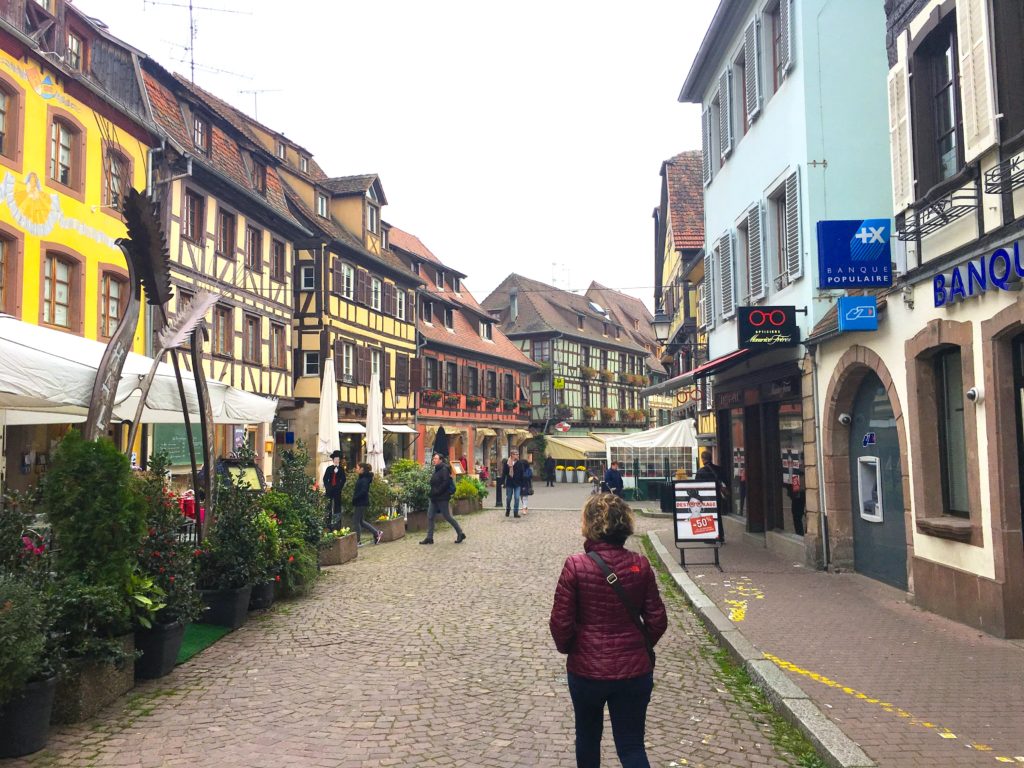
Obernai is one of the Alsace Wine Route towns closest to Strasbourg. It was bigger than the other Alsatian little towns and felt like it had more city vibes. On the other hand, it still had its traditional half timbered architecture, its little town square with a tower, and a great pedestrian Main Street. Obernai was a beautiful last stop on our Alsace Wine Route before the city of Strasbourg.
Strasbourg: The capital of Alsace
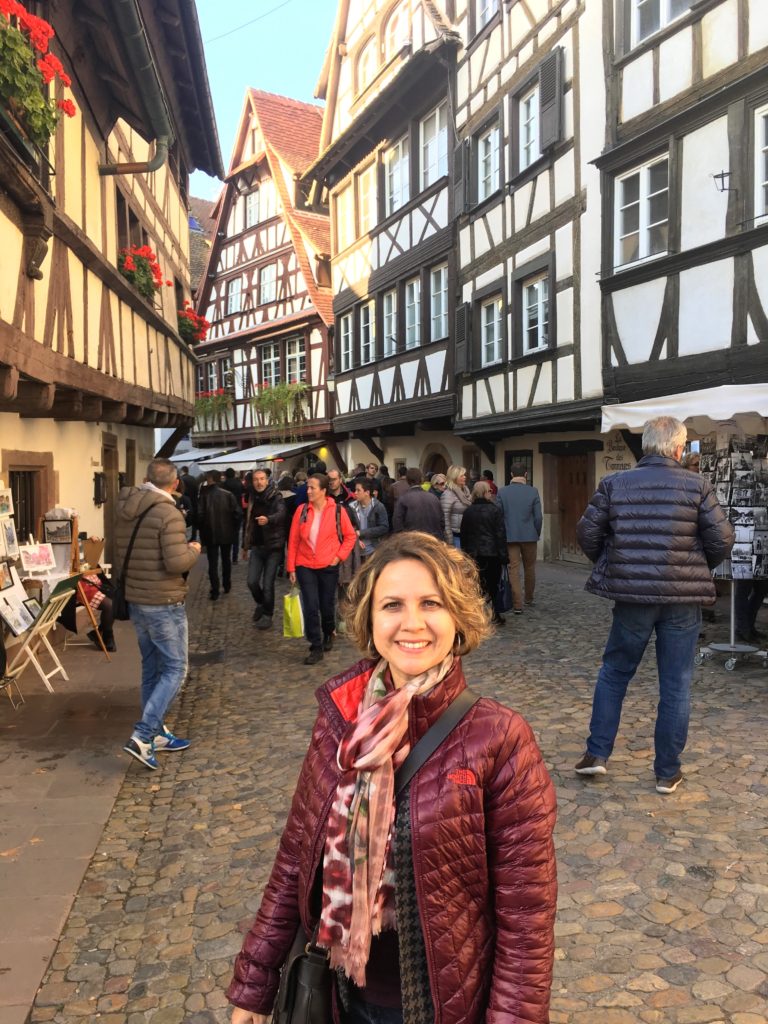
Strasbourg is the capital city of “Grand Est” (formerly known as Alsace) in France. It is the seat of European Parliament and also a beautiful historical city which is a Unesco World Heritage Site with both its old town (The Grande Ille) and its “new town” (Neustadt).
Must see attractions in Strasbourg
The Strasbourg Cathedral
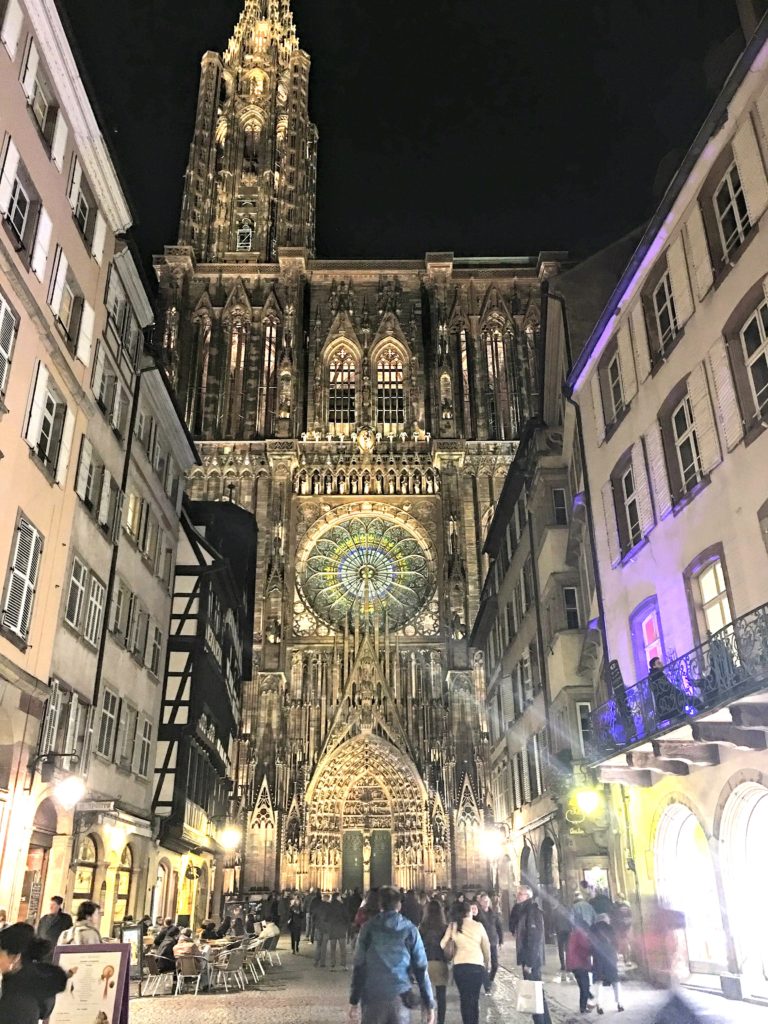
The Strasbourg Cathedral is the symbol of the city. This masterpiece of gigantic Gothic architecture was completed almost in 3 centuries. The 142 meter tall spire was the tallest structure in all Christendom until 19th century.
The Grande Ile
Surrounded by Ill River, the Grande Ile is the historic center of Strasbourg. In addition to the Strasbourg Cathedral, there are plenty of places to see there. The famous Krammerzell House, Rohan Palace, the main squares of Place Kleber and Place Broglie must not be missed. The Grande Ile is a Unesco World Heritage site since 1988.
The Capital of Christmas
Strasbourg is known as “The Christmas Capital” because its “Christkindelsmarik” (Christmas market in Alsatian) takes place throughout December in Place Broglie since 1570. It is the oldest one in France and one of the oldest in Europe.
The Petite France
It was the district of millers, tanners and fishermen in the past who lived and worked in the half-timbered houses throughout this area. Today it is a beautiful place with charming Alsatian architecture, narrow streets and a waterfront romantic atmosphere. Actually, it looks like the urban version of the villages we had visited through the Alsace Wine Route.

The Ille River is everywhere in Petite France, that’s why the district is sometimes compared to a little Venice. You can explore the many historical bridges, quays and the Vauban Dam there on foot or by a tour boat.
The Neustadt District
Neustadt means “new city” and it is an impressive district with squares, wide avenues and historical buildings. Its name is “new” but it actually was built between 1871 and 1914. The Neustadt is a Unesco World Heritage site since 2017.
The European District
It is interesting to visit a district full of buildings that we hear in the news all the time. The European Parliament, Palace of Europe, that is the seat of Council of Europe, The European Court of Human Rights are all located in the European District in Strasbourg.
Where to stay in Strasbourg?
In Strasbourg, we preferred to stay a little further than the city center in order to have free parking in the hotel. We left the car in the hotel and used public transportation to get in the center of the city. Although it was quite doable I wouldn’t choose to stay there another time. In case I visit Strasbourg again I would love to stay in the hotels like:
- Hotel Des Vosges BW Premier Collection: (Booking.com score 8.6 / from more than 1800 reviews) A hotel close to the train station and city center, walking distance to the cathedral. It offers renovated rooms and a discount ticket for the parking nearby.
- Le Grand Hotel: (Booking.com score 8.2 / from more than 4300 reviews) It is a more affordable hotel opposite the Strasbourg train station and 10 minute walk to the city center. It offers breakfast buffet and also has discounted parking agreement with the parking nearby.
For more options Strasbourg hotels, please click here.
Where to eat in Strasbourg?
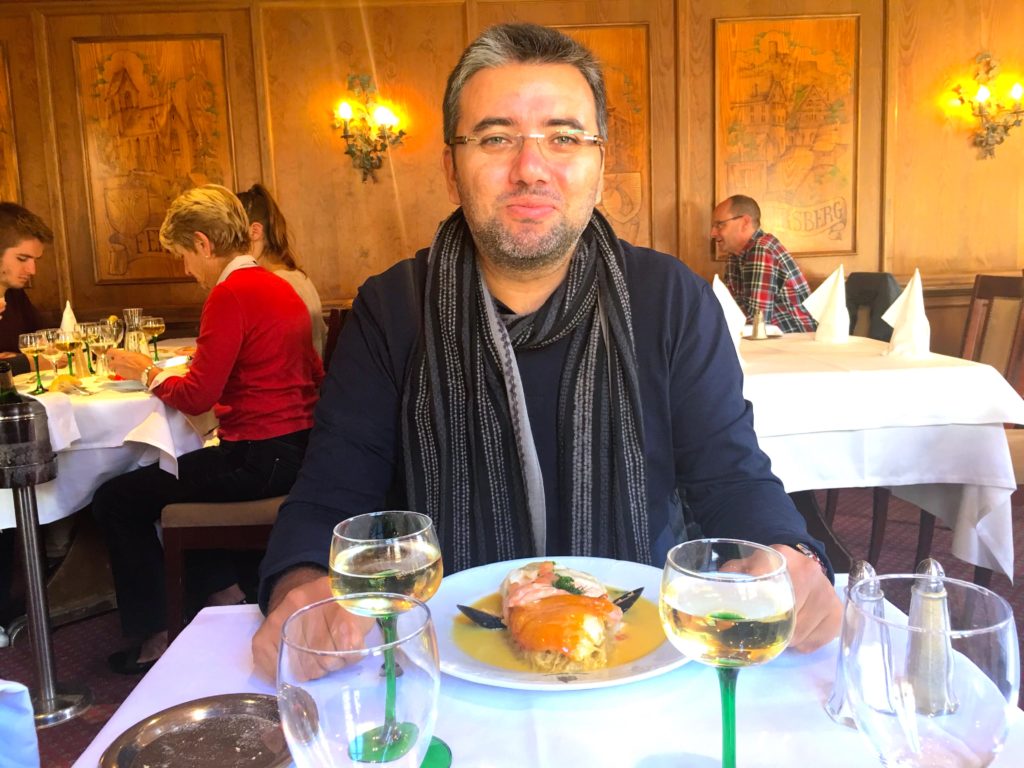
For our last meal in Alsace we chose to eat in Maison Kammerzell, a restaurant which dates back to 1427. The House Kammerzell itself is one of the most famous buildings in Strasbourg with its well preserved medieval Gothic architecture. This symbol house and restaurant is located just next to the Strasbourg Cathedral.
We had another choucroute there with fish this time. Definitely, couldn’t resist to some foie gras at the city where it was invented. Also, we had our Alsace wines in traditional, slender leg, green base, and so appealing to eyes, Alsace glasses. It was a lovely meal in an incredible setting.
Driving through Black Forest, Germany

After we drove all the way up through the Alsace Wine Route from Mulhouse to Strasbourg, it was time to go back to Basel Mulhouse Airport. Definitely, we weren’t going to drive back through zigzaggy wine route all the way back. In fact, we had two options. Either, driving through highway A35 and reaching the airport only in one hour and a half. Or, making a quiet detour through Black Forest in Germany and peeking into a brand new country for us. Although the second option was a journey about three hours, without a doubt we chose that one and saved our last day in the region for a little German adventure.
Crossing the German border
We set off early in the morning from Strasbourg to the German border. Actually, we haven’t crossed any land borders in European Union before and didn’t know what to expect. In reality, when we reached the border we saw a bridge above the River Rhine. We drove through the bridge and at end of the bridge glimpsed a “Welcome to Germany” sign. That was all! No border checks, no waiting, nothing. We crossed a bridge and suddenly the language, the architecture, everything changed…
We drove in Black Forest (Schwarzwald in German) through roads in quite good condition. It was a pleasant journey surrounded by forests and here and there passing by traditional German mountain houses. After one hour and twenty minutes we were in a touristic German mountain village: Triberg.
Triberg: a village in the heart of Black Forest

Triberg im Schwarzwald is conveniently located in the heart of Black Forest. This little village is famous for its cuckoo clocks, waterfall and its Black Forest cake.
The Triberg Waterfall
The Triberg Waterfall is Germany’s (one of the) highest waterfall. It falls a total of 163 meters in a series of cascades. There is an argument about whether the waterfall is the highest or not, but I don’t think there is a need for discussion on numbers. The waterfall is so beautiful anyway! And, it is easily accessible with just a short hike from the town center.
Cuckoo clocks of Triberg
Cuckoo clocks are quite interesting tourist attractions in Triberg. They are everywhere! There is even a store named “House of 1000 Clocks” and there are literally hundreds of cuckoo clocks displayed in it. Handcrafts, particularly carving, has been popular in the region for so long. Hence, a man named Franz Kellerer, invented the first cuckoo clock in Schonwald, a village very close to Triberg. Then, another man in Triberg completes the work and combines clockwork, house and carving to the cuckoo. Today, Triberg cuckoo clocks are world famous and they can be found in any shape, size and price.
Black Forest cake
Black Forest Cake is Gateau style chocolate cake soaked in cherry schnapps (liquor), filled and frosted with whipped cream, cherries and chocolate shavings. Actually, Black Forest is also famous for its Morello cheries, Kirsch (a brandy made from morello cheries and sour cheries) and dark chocolate. Bring them altogether and you have the Black Forest Cake! 🙂
Cafe Schaffer in Triberg claims that they have the original recipe of Black Forest Cake, invented by Josef Keller in 1915. Since it was still early in the morning, we couldn’t try the Black Forest Cake (Schwarzwald Kirschtorte) in Triberg and left it to try in our next and last stop in Freiburg.
Freiburg: the sunniest city in Germany
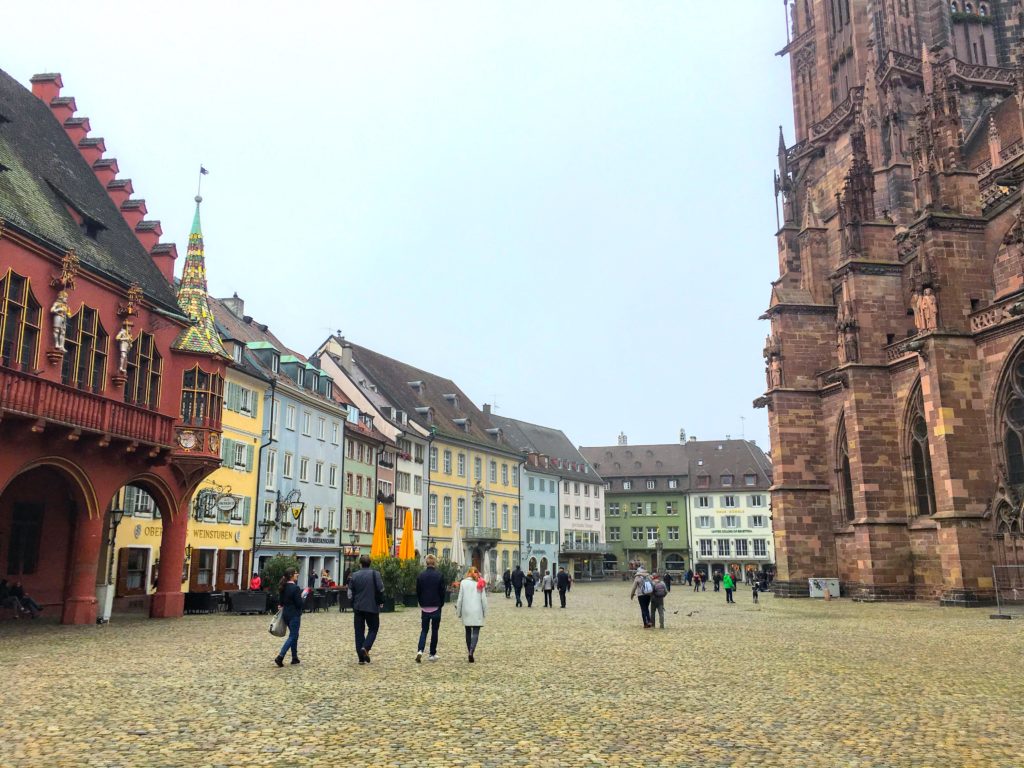
Freiburg is located at the most southern west part of Germany and is just on the edge of Black Forest. It is known as one of the sunniest parts in the country. Although Freiburg did not show us even a glimpse of its sun :), it was a lovely last stop on our road trip.
Freiburg has a beautiful old town, lively streets full of people no matter how the wether is and a delightful atmosphere. We walked around the old town and really liked this cute place. Soon after, escaped from the cold outside and got in a cafe where we finally tried the Black Forest cake. Following that, we found another cozy place full with people, in one of the oldest brewery in town: Hausbrauerew Feierling. We enjoyed some Baden cuisine and made a toast for our unforgettable road trip!

Our Alsace region road trip with a detour to Black Forest was undoubtedly our best trip of the year. Previously, we have visited Paris multiple times, been in south France and explored around Nice and Cannes but it was our first time visiting such an authentic region in France. I am so glad we made it!
